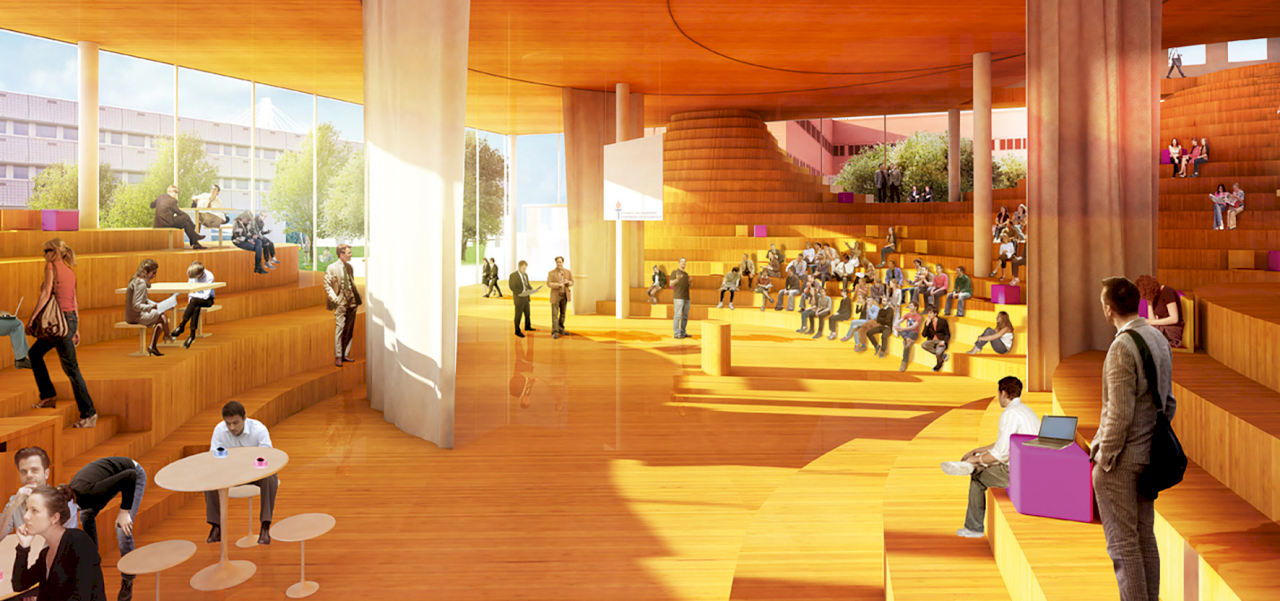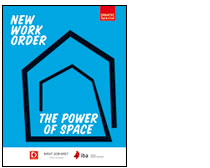
Find out more
Every space has an impact
During the Covid-19 pandemic if not before, most managers and their employees realized how much flexibility is offered by location-independent communication based on digital platforms. However, the longer people stayed away from their shared place of work, the more clearly they realized how important it is to be physically present in a shared space.
The Hamburg-based trend expert Birgit Gebhardt devoted a special issue of the “New Work Order” studies to physical space and the opportunities it offers. You can read about the results in the “New Work Order” special issue “The Power of Physical Space”. Below you can find a short selection of the themes that are addressed there.
THE QUESTION OF THE BEST WORK ENVIRONMENT IS BEING ANSWERED ON AN INDIVIDUAL BASIS
Perhaps the most important thesis of this publication is that in the future employees will decide for themselves, probably on the basis of very personal reasons, when and where they work. That applies not only to the question of where to work — from home, at the office or in a third place of work. It also applies to the physical spaces of the shared office itself. It’s likely that employees will soon be able to receive support from smart technology for the decisions they make every day. In the same way that smartwatches today provide feedback about the status of their wearers’ health, in the not-too-distant future there will probably be apps that can give users feedback about the well-being and productivity that specific physical spaces can enable. For companies, this means they must allow every individual employee and every team to organize themselves, and also that they must provide a wide spectrum of different workrooms — in the office, in rented co-working spaces or in workspaces they share with neighbouring companies.

The office as a space for experiences
The added value of the office lies in its multifaceted range of spaces, which stimulates us and binds us together in new ways through our senses and through media technology. Its key qualities are fewer standards, smarter equipment, a bolder profile and a more communicative environment.
Source: The “New Work Order” special issue “The Power of Physical Space”, 2022
WILL THE OFFICE BECOME A STAGE?
This question may seem nonsensical, but only at first glance. In her study, Birgit Gebhardt points out the town hall meetings in which CEOs talk about goals and take questions from the workforce. There, physical space becomes a stage that can either generate a sense of closeness or purposely reinforce a sense of distance and fascination, depending on how it is designed. However, in the hybrid world of work it’s not only the managers who need a stage. The cooperation within a team also benefits from staging. The way the physical space is staged can strengthen team processes and thus have a positive effect on creativity and work results. The office as a stage purposely creates visibility while simultaneously offering space for shared experimentation.



ENTREPRENEURS IN CULTURE SHOCK
Thinking of the office as a theatre or a cultural landscape has another advantage. That’s because during hybrid or remote work, physical distance can quickly generate emotional distance. To prevent this from happening, employees need to have shared values and experiences. This is where the office basically has an advantage over virtual space, because it appeals to more senses and can enable people to directly experience the corporate and work culture.
- IDENTITY: Loyalty to a company and team cohesiveness aren’t created on the drawing board. For a long time now, Google has been showing how the inclusion of local reference points in spatial design can strengthen employees’ loyalty to an international company.
- COLLABORATION: A well-functioning office landscape needs to design collaboration more efficiently than has previously been the case. To this end, people need to have the possibility to meet so that they can get to like each other — in attractive communication areas and quieter zones.
- WELL-BEING: The multi-space office offers areas that meet people’s varying needs for concentration and creative closeness or retreat and recuperation. The use of plants, daylight and decorative objects has been shown to enhance performance..
- MEANINGFULNESS: In order to feel that their work is meaningful, individuals must have a clear concept of their own contribution to the overall result, as well as everyone’s shared contribution. This creates a stage for presenting the company’s overarching goals and the individual’s own contribution to them.
CLARIFYING COLLABORATION - EXAMPLES
When it comes to fostering collaboration, companies also need to find the way that works best for them. The New Work Order study "The Power of Space" provides examples.
“How do you want to work?” was the question posed by the German online retailer OTTO to its employees. In reaction to the employees’ answers, OTTO reduced the number of areas for concentrated solo work, which the company calls “libraries” in line with its design models. In their place, the company set up flexible “project garages” in the future for confidential work as well as for work in open spaces.
At the SPOTIFY streaming service, the office is a place for camaraderie, onboarding and solving critical problems. To carry out their activities, the teams can rent rooms with work tables for a maximum of eight people plus a creative lounge and a quiet area.
At SWISSCOM IMMOBILIEN AG the strategy is to reduce the influence of the people who are responsible for workstation design and instead to find out through closer observation what really serves the users. In many areas, uniform rules were abolished. For example, the employees can decide for themselves whether or not they want to share their desks with others. The company believes the purpose of the office is to enable employees to develop a shared understanding of what can, and will, advance the company’s interests.
The ADOBE software company is focusing on a holistic concept of well-being for its workstations. This concept ranges from ergonomic workstations to consultations with nutritionists. Entrance areas are being designed as lobbies, and the company’s San José branch is deliberately experimenting with a new design of the transitional areas between different zones that reinforces the employees’ experience of different atmospheres.
DEDICATED PLACES – WHAT DIFFERENT ROOMS ENABLE
In the final chapters, Birgit Gebhardt presents toolkits that can be used to support agile spatial concepts adapted to the needs of individuals and teams. She uses two scenarios to take a bold look at the future of the office as part of a city or a rural region.

You can order the study free of charge as a print copy or download it as a PDF.

